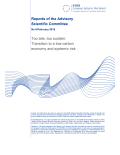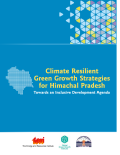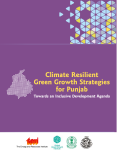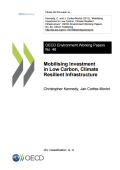
Keeping global warming below 2°C will require substantial reductions in global greenhouse gas emissions over the next few decades.
This report highlights that leaving the transition to a low-carbon economy too late risks affecting the economy of the European Union in three ways:
- first, a sudden transition away from fossil-fuel energy could harm GDP, as alternative sources of energy would be restricted in supply and more expensive at the margin;
- second, there could be a sudden repricing of carbon-intensive assets, which are financed in large part by debt;
- third, there could be a concomitant rise in the incidence of natural catastrophes related to climate change, raising general insurers’ and reinsurers’ liabilities.
A gradual transition to a low-carbon economy is therefore seen as the best option; this choice would be better manageable and would prevent energy costs from rising abruptly. Furthermore, additional policy intervention and investments in low-carbon technology are likely to help in preventing greenhouse gases in the atmosphere from growing in the medium term.

Himachal Pradesh is a mountain state in India which benefits from a wealth of natural resources but is also ecologically fragile, being situated in the Himalayan region. With climate change, socio-economic and ecological vulnerability has increased and risk-based approaches have become even more relevant. Green growth and sustainable development need to take into account the impacts of climate variability to strengthen policy interventions.
This report carries out an analysis aimed to build knowledge in this area. It uses a mix of analytical tools including a climate model, soil and water assessment, and energy analysis. The report finds that the overall climatic warming projected for the state of Himachal Pradesh in the near future increase by 1.3–1.9°C for 2021–50 relative to 1971–2000. Through a state-specific energy model and onground case studies, the report identifies important issues and pressure points, relevant for the energy and environment sectors.

Punjab is a small Indian state that contributes significantly to India’s food security. While the production potential of rice and wheat crops have almost been fully exploited, there is now a stagnation in the growth process, decline in real farm incomes, and over exploitation of natural resources vis-a-vis soil health and water quality and quantity. With climate change, socio-economic and ecological vulnerability has increased and risk-based approaches have become even more relevant. Green growth and sustainable development need to take into account the impacts of climate variability to strengthen policy interventions.
Climate change has financial implications for investors – presenting significant portfolio risks as well as new market opportunities. This paper explores the landscape of climate exposure and examines the strengths as well as some of the current limitations of ESG data, tools, and financial products.

This paper addresses several broad issues for governments aiming to encourage private sector investment in low-carbon climate resilient (LCR) infrastructure, in both developed and developing world contexts. LCR infrastructure is defined, recognizing the interdependencies between infrastructure systems, and the opportunities to tackle climate change adaptation and mitigation simultaneously in national strategic infrastructure plans. Review of the performance of OECD countries in reducing greenhouse gas emissions related to three categories of gross fixed capital formation is mixed. Half of the countries analysed achieved decoupling of emissions from capital formation in the residential building sector, but only two in the transportation sector and nine in power and industry. The paper reviews future global infrastructure needs under low carbon and business-as–usual scenarios. Although cost estimates are incomplete, the technical interdependency and financial tradeoffs between infrastructure systems suggests the potential to generate virtuous cycles of low carbon growth.
